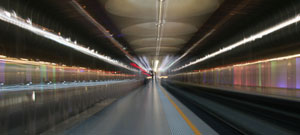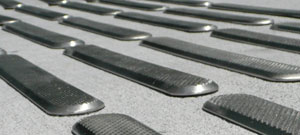FAQ
- What are Tactile Indicators?
- What is the difference between Warning and Directional Tactile Indicators?
- What type of Tactile Indicator is best for my project?
- What materials are Tactile Indicators made from?
- Does my project require Tactile Indicators?
- Do they have to be yellow?
-
What are Tactile Indicators?
Tactile ground surface indicators (TGSI's) are products made from various materials that have either raised truncated domes and directional bars and are built into or applied to walking surfaces.
Tactile Indicators are designed to give warning of hazards & directional information to pedestrians who are blind or who have impaired vision through contact by foot or cane with the ground surface.
Pedestrians with limited vision use the colour contrast to detect the modules visually. -
What is the difference between Warning and Directional Tactile Indicators?
Warning Tactile Indicators - are also referred to as Hazard Tactiles.
Warning indicators are intended to function much like a stop sign. They alert pedestrians who are blind or vision-impaired to hazards in their line of travel, indicating that they should stop to determine the nature of the hazard before proceeding further. They do not indicate what the hazard will be.
Directional Tactile Indicators - also referred to as Leading Tactiles.
They are installed to safely lead pedestrians along an intended pathway free of obstacles and will often terminate at a pad of Warning Tactile Indicators.
-
What type of Tactile Indicator is best for my project?
For outdoor applications all three systems can be used – concrete, polyurethane or stainless steel.
Precast Concrete Pavers – Are generally used outdoors for new projects.
They are a robust solution; if it is likely that vehicles will come into contact with the Tactile Indicators, high specification precast concrete pavers are the best option – they should be at least 60mm thick – any less and the pavers are susceptible to cracking under vehicular weight.
If the installation is indoors it is unlikely that precast concrete pavers will be acceptable. Additionally, if the area to be installed is pre-existing i.e. the concrete, asphalt or paving is already laid, it may be impractical or onerous to saw-cut the required area, lay the pavers and reinstate the surrounding substrate all perfectly flush. In these situations one of the individual stud systems in polyurethane or stainless steel will be a more practical option.
Architectural preferences and budget factors will come into play regarding the choice between the polyurethane and stainless steel stud systems. Quality and installation integrity must also be taken into consideration.
Polyurethane Tactile Indicators - for interior and exterior use, retro-fitted to new or existing surfaces.
Are a hard wearing and tasteful solution that can be installed indoors or outdoors, to new or existing surfaces. They are designed as a retro-fit system, meaning they are installed after the substrate has been laid and are ideal for existing surfaces. Our Polyurethane Tactile Indicators are designed and manufactured in New Zealand to a very high specification. The standard colour is Safety Yellow but they can be manufactured in practically any solid or metallic colour.
Stainless Steel Tactile Indicators - A retro-fit system for interior and exterior use.
They are a premium and stylish solution manufactured from high grade 316 marine grade stainless steel. As with the Polyurethane Stud System, they can be installed indoors or outdoors, to new or existing surfaces. They are designed as a retro-fit system, meaning they are installed after the substrate has been laid and are ideal for existing surfaces. Our Stainless Steel Tactile Indicators are designed in New Zealand and manufactured to a very high specification. Quality Brass and other types of alloy Tactile Indicators are also available for special projects.
Additional Options - On occasion it is impractical to drill into the substrate, for example, where metal service hatches and manhole covers intersect a tactile area. In this situation Tactile rubber or plastic sheet tiles may have to be glued to the surface. It is important that high quality products and adhesives are used as inferior installations can fade, crack or lift causing dangerous tripping hazards.
Mobility Research is happy to advise on the most suitable Tactile Indicators for you project – contact us.
-
What materials are Tactile Indicators made from?
As long as they comply with the relevant standards relating to dimensional and spacing requirements, Tactile Indicators can be manufactured from any material that will stand up to the installation environment.
Durable materials are used including corrosion resistant metals such as stainless steel, brass, and aluminium, high strength concrete and ceramics and hard wearing rubbers and plastics.
The most commonly installed Tactile Indicators in New Zealand are concrete, in the form of precast concrete paving units and polyurethane plastic and stainless steel, installed as individual studs.
-
Does my project require Tactile Indicators?
If the general public, including the blind and vision impaired have use of the facility or has access to or through it and there are collision or tripping hazards or hazards with the potential to result in a fall – Tactile Indicators are a mandatory requirement.
It is not unusual for Tactile Indicators to be overlooked when plans are drawn up. Last minute CPU (Certificate for Public Use) headaches can be avoided by checking with the architect, consultant or council as to Tactile Indicator requirements for your project.
Mobility Research Centre offers a cost free consultation service where we are happy to advise on standards, layout guidance and can seek clarification from architects, consultants or council representatives.
-
Do they have to be yellow?
No, however safety yellow is the recommended standard colour for Tactile Ground Surface Indicators. Mobility Research can manufacture both precast concrete and polyurethane TGSI in a vast range of colours. We are happy to discuss contrast requirements and recommendations with you to ensure they comply but also look good in your project.
Safety yellow
Research by Bentzen et al (Accessible design for the blind, May 2000) indicated that the colour ‘safety yellow’ is so salient, even to persons having very low vision, that it is highly visible even when used in association with adjoining surfaces. Their research found that safety yellow TGSI having a 40% contrast from new concrete was subjectively judged to be more detectable than a darker TGSI having an 86% contrast with new concrete.





